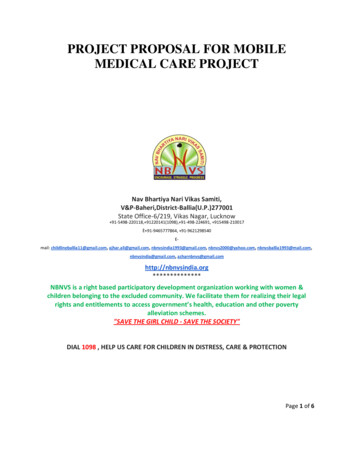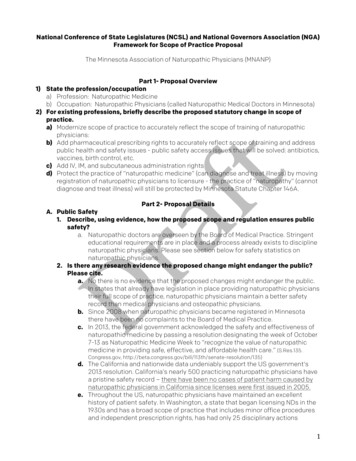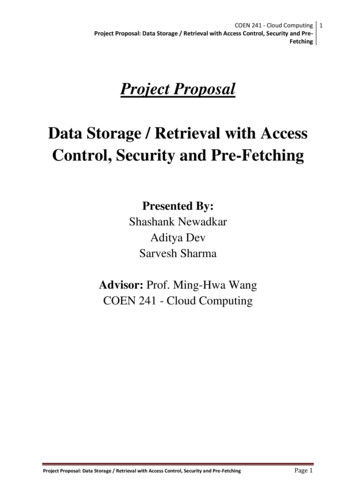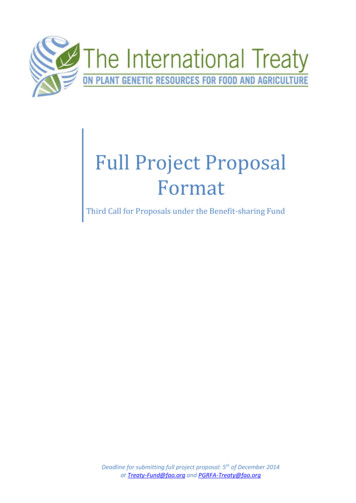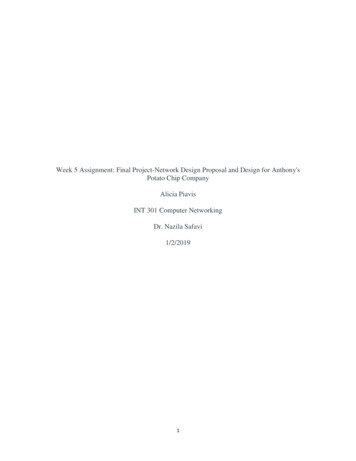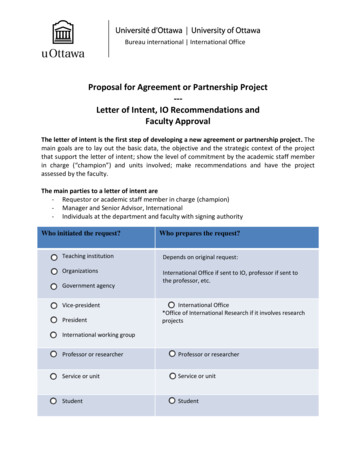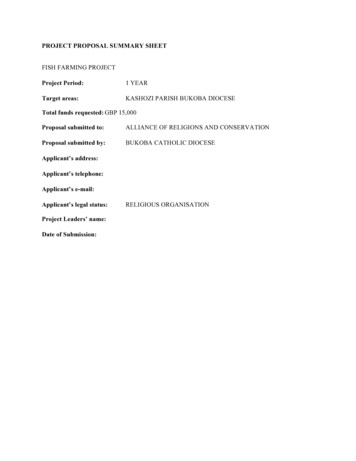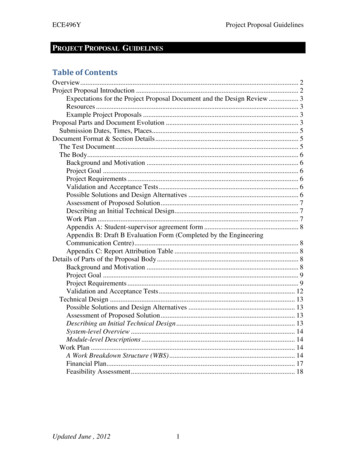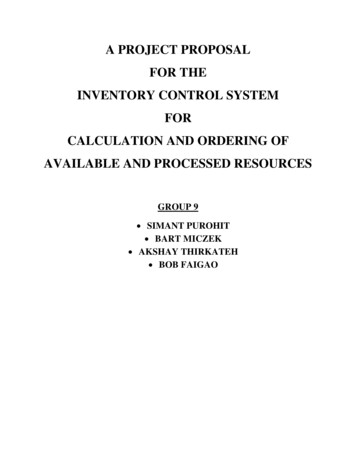
Transcription
A PROJECT PROPOSALFOR THEINVENTORY CONTROL SYSTEMFORCALCULATION AND ORDERING OFAVAILABLE AND PROCESSED RESOURCESGROUP 9 SIMANT PUROHIT BART MICZEK AKSHAY THIRKATEH BOB FAIGAO
Executive SummaryOur proposed project is a real time implementation of an inventory control system for an on-sitecorporate restaurant management and catering company. One such company is Guckenheimer(www.guckenheimer.com) which builds, staffs, and upkeeps corporate kitchens as well asprovides catering services to corporate companies. This project is specific in that it applies to thedining domain of restaurants, but is flexible enough to be applied to many different kitchens andrestaurants. In the case of Guckenheimer, they can use the software in their kitchens across thenation. The scope of this project will primarily focus on Guckenheimer’s kitchen and inventorylocated at the Groupon Chicago Office.Currently at Groupons kitchen, and the food industry in general, restaurant staff and managersare forced to keep track of inventory by hand. This means that they must count what they havesold and what they have left at the end of each day. They must also fill out order forms to be sentto vendors so that they can restock their inventory in preparation for the next week. This wastesvaluable man hours and is a rather simple task to automate using our software.We propose a solution to this issue by developing software that keeps track of inventory in the“back of house”, or kitchen, and updates it according to daily sales. Each food item is linked torespective resources (or ingredients) and as each product is sold the ingredients utilized inmaking that product are also utilized. These changes in inventory are kept track of throughutilizing a database.We propose to keep track of each and every ingredient by dynamically linking it to the productand as a result create a dependent relationship to that product. At a specific time period (typicallythe end of the week); if the inventory is below the threshold level, order forms to the specificvendors are generated in order to restock the required items for the next week. The project alsomakes smart predictions on required inventory for the following week based upon the predictedclimate and possible occasions or events that may influence near future sales. At the end of theweek, the software takes into account all threshold levels, predictions, and other factors togenerate an order form, which after being verified by the manager is sent out to the vendors.
The Purpose of the ProjectA case study at ‘Guckenheimer’ (an on-site corporate restaurant management and cateringcompany) cited issues regarding a basic resources requirement list that has to be maintainedmanually by the staff. To keep track of their inventory levels they have to calculate a list of thegroceries utilized during a course of time, calculate and analyze the requirements for the future,and place their next order to the vendors if needed. This process takes up a lot of time and humaneffort, and is also prone to human error.This poses a problem of a situation that the staff at ‘Guckenheimer,’ as well as many otherrestaurants faces. It takes up a lot of time to manually keep track of sales and place correct ordersto vendors, wasting useful labor in trivial works. A product which would assist in tackling theabove mentioned problems would prove to be fruitful to clients such as ‘Guckenheimer’ andsimilar enterprises as this product would help convert the unproductive time to something moreuseful, by removing the unnecessary error prone complications and efforts.Goals of the ProjectThe project aims at providing an efficient interface to the restaurants for managing their groceryinventory based on each item sold. The basic idea involved here is that each item is linked to itsatomic ingredients which are stored in a database. At the end of each day, the system analyzesthe total sale of menu items and proportionately deducts appropriate amount from the resourcedatabase. Then it compares the current available resources with the threshold level of eachingredient. If it finds that certain ingredients are below the threshold, it will generate a purchaseorder for those item(s) and send it to the manager (admin) for approval.We also propose to include a special feature “Prediction”. This feature keeps track of anyupcoming occasions, climatic changes and special events that may influence inventory needs forthe upcoming week. The system will then predict the required resources for these events basedon previously accumulated information/knowledge. It will now generate an updated purchaseorder in accordance with the predictions.The product also aims to keep track of the shelf life of resources. If any resource nears the end ofits shelf life, it would intimate to the manager (admin) the details of the quantity that is near itsexpiration date. The restaurant must function efficiently, the groceries must be tracked correctly,timely orders must be sent out to the vendors, and the inventory must be maintained and updatedat all times.
The DomainThis proposed project aims at inventory control in the restaurant and catering Industry. Such alarge domain would result in an equally as large scope of development. As a result we narrowour software down to our case study of an outlet of Guckenheimer concentrating only on thebasic resources utilized in inventory control of the outlet. Although the software will bedeveloped keeping in mind the needs of Guckenheimer and available data at first, then applyingit to the larger domain of the entire restaurant industry can be achieved with ease.Our target domain is full of software to track sales of food items, but lacks in this area ofinventory management. Our software can be scaled from large corporate dinings all the way tosmall privately-owned restaurants. It is also fairly domain specific: the database runs off recipeswhich generate the necessary ingredients. It also updates the inventory based off of the sale ofthose recipes. This requirement focuses our product to our domain and makes it more appealingto those looking for a solution to this specific problem.The ClientThe client can vary from private restaurant owners to corporate restaurant managementcompanies, such as Guckenheimer (www.guckenheimer.com). A corporate restaurantmanagement company that starts up, staffs, and oversees the everyday workings of a corporaterestaurant, such as the one in the Groupon Chicago office. As stated above, while our productcan be applied to the entire domain of the restaurant and catering business, focusing on a specificbusiness provides us with more precise and consistent data. A company such as Guckenheimerwould be an ideal client, as they staff multiple corporate kitchens across the nation, includingkitchens for Groupon and even Google. A large scale company such as this this can apply oursoftware to each and every kitchen, cutting down costs on a very large scale.Our software will allow our client to customize the database to suit the needs of each kitchenindividually. They can vary in recipes, vendors from which they order their products, andthreshold levels. This provides a uniform product that can be customized at a smaller scale. Ourclient would need to purchase multiple licenses, or more likely a corporate subscription thatwould allow them to use the software in multiple kitchens. We would also offer single uselicenses to appeal to restaurants that only need to manage a single inventory of goods.
User of the productThe main users of the product would be kitchen management and staff. The management wouldapprove the orders that would be sent out, provide vendor information, upload recipes, and setthreshold levels. Many of these tasks, such as the information regarding vendors, recipes, andthreshold levels would need to be set only once. Of course, the option to add, remove, or updatethis data would be implemented as well. Once this initial step has been taken, our software willrequire nothing more than a weekly approval for the orders being sent out, minimizing the workthat management has to complete in order to insure the correct amount of inventory is available.Kitchen staff would be responsible for updating the amount of product sold at the end of the day.Each day, the register prints out the products sold and the quantity of each product sold. Insteadof manually subtracting that amount from the inventory, they input the amounts sold into oursoftware which will do the number crunching for them. This data is also stored into the“predictions” feature for future use.Domain ExpertMs. Kimberly Harmon, employee of Guckenheimer, chef at Groupon Chicago OfficePhone: 801.361.6597Email: kharmon128@hotmail.com
Hardware RequirementsProcessor - Intel Dual-core processor, 2.0 GHz or higherRAM - Minimum 2 GB of RAMNetwork interface chipHard Drive - 500 GBSoftware RequirementsOperating System: Windows XP or higher.Front End: VB.NET (Visual Studio 2010)Back End: Microsoft Access 2010
Overall UML Diagram
Typical Use Cases1) Update resource databaseUse case ated by Manager(admin) or ChefFlow of events1. The Manager or Chef activates the update resource database function2. The Manager or Chef inputs the amount of each item sold.3. The System reads the sold food data and then further reads, from theingredients database, the ingredients that were used in making of the food itemsthat were sold. The System now calculates the amount of resources used andwill deduct the amount of ingredients that were used up from the resourcedatabase.EntryconditionThe Manager(admin) or Chef is logged on to the SystemExit conditionIf the process was successful, the Manager/Chef receives an acknowledgementthat the process was completed successfully.ORIf the process was not successful, the Manager will receive an explanation ofwhat error had occurred during the process.QualityRequirementsThe update process must complete successfully and without errors.
2) Check inventoryUse case nameCheckInventoryParticipatingActorsInitiated by Manager(admin) or ChefFlow of events1. The Manager/Chef activates the “Check Inventory’ function on his/herterminal.2. The System displays the current estimated inventory of ingredients to theManager/Chef.4. The System will compare the current levels of ingredients with the pre-setthreshold levels.5. If the levels of ingredients are found to be below threshold, it will createorders for purchase and sends it to the Manager for approval.6. The Manager/Chef is notified of the process completionEntry conditionThe Manager/Chef is logged into System.Exit conditionSuccessful Acknowledgement.QualityRequirementsThe function accurately calculates the inventory that should be left when allof the orders have been calculated
3) Add RecipeUse case nameAddRecipeParticipatingActorsInitiated by Chef/ManagerFlow of events1. The Chef/Manager activates the “Create New Recipe” function on his/herterminal2. The System responds by presenting a form to the Chef/Manager3. The Chef/Manager completes the form by inserting ingredients to be used inthe new recipe. The Chef also inputs the amount of ingredients to be used in asingle order of the recipe. After the form has been completed the Chef submitsthe form to the System.4. The System acknowledges that the new recipe has been created. It also addsit to the recipe database.Entry condition The Chef/Manager is logged into SystemExit conditionThe Chef/Manager has received an acknowledgment from the System.ORThe Chef/Manager has received an explanation of why the process couldn’t becompleted.QualityRequirementsThe process must complete successfully with the new recipe added to therecipe database without any errors.
4) Update recipeUse case nameUpdateRecipeParticipatingActorsInitiated by Chef/ManagerFlow of events1. The Chef/Manager activates “Update Recipe” on system2.System responds by bringing up list of recipes3. The Chef/Manager chooses a recipe to change4. System updates by showing list of ingredients in chosen recipe5. The Chef/Manager changes the recipe by choosing new ingredients orupdating the amount of ingredients used in the recipe. The Chef then finishesthe update by selecting the finished command on the system.6. The System confirms that the change has been made and updates thedatabase.Entry conditionThe Chef/Manager is logged into SystemExit conditionThe Chef/Manager receives an acknowledgment from the System,ORThe Chef/Manager has received an explanation of why the process couldn’t becomplete.QualityRequirementsThe update process must be complete successfully without any errors.
5) Remove recipeUse case name RemoveRecipeParticipatingactorsInitiated by Chef/ManagerFlow of events1. The Chef/Manager activates the “Remove Recipe” function on his/herterminal2. The System responds by showing the current list of recipes saved on theSystem.3. The Chef/Manager chooses which recipe(s) to remove and removes them byselecting a delete button through the terminal window.4. The System confirms with each deletion with the Chef/Manager if he/shewants to delete the recipe.5. The Chef/Manager confirms his/her decision with a yes/no6. The System acknowledges the decision by either removing the recipe ifresponded with “yes” or by canceling the delete if responded with “no”. It thendisplays an acknowledgment of the decision by displaying a delete successfulor a canceled request.7. The System notifies the Chef/Manager about the change and requests newthreshold levels for ingredients from deleted recipes.EntryconditionThe Chef/Manager is logged in SystemExit conditionThe Chef/Manager has received an acknowledgment that the recipe has beendeleted.ORThe Chef/Manager has received an acknowledgment that the recipe has notbeen deleted.ORThe Chef/Manager has received an explanation of why the process couldn’t becompleted.QualityRequirementThe removed recipe
The Chef/Manager activates the “Create New Recipe” function on his/her terminal 2. The System responds by presenting a form to the Chef/Manager 3. The Chef/Manager completes the form by inserting ingredients to be used in the new recipe. The Chef also inputs the amount of ingredients to be used in a single order of the recipe. After the form has been completed the Chef submits the form to .
